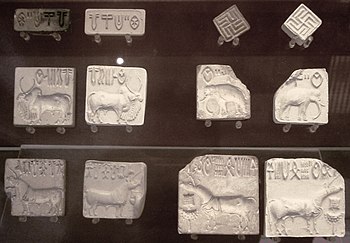Indusschrift

The corpus of linear and pictographic characters on objects of the Indus culture is called Indus script . These signs were used on various objects during the urban phase of the Indus culture (approx. 2500–1900 BC). With the end of the urban phase of the Indus culture, they disappeared as suddenly as they appeared. Until the advent of the Brahmi script (from around the 3rd century BC), they remained the only script on the Indian subcontinent for a long time. The characters have not yet been deciphered. Its character as a font is accepted by most researchers, but is controversial among some.
Details
origin
The origin of the Indus script has not yet been clarified beyond doubt. Assumptions that it could have common origins with the Proto- Elamite script have not been confirmed. It is possible that the system was developed in the transition period from the protourban to the urban phase (≈ 26th century BC) from individual signs that can be traced on utility ceramics.
system
So far it has been assumed that it is a logo-syllabic font because the number of characters (400–650 depending on the author) is too small for a purely logographic font and too large for a purely syllabic font. This means that the system would be structurally comparable to cuneiform or Maya script . There is a lively discussion about the exact number of characters, since in many cases it is unclear whether certain characters are variants ( allographs ) of the same basic character (grapheme) or whether they must each be evaluated as independent symbols (graphemes). There is consensus that writing was done from right to left. The longest inscription consists of 27 characters, the average is 4.7 characters per text. Many "texts" only consist of a single character.
use
The signs of the Indus script are mainly found on the mostly rectangular stamp seals of the Indus culture and, to a lesser extent, on seal impressions of the same and on copper plates and metal objects. A total of around 4,350 objects were recovered from various excavations, mainly in Pakistan, but also in India, Afghanistan and occasionally in Mesopotamia.
The End
With the end of the urban phase, the partialization and regionalization of the communities of the Indian subcontinent, around 1900 BC BC as well as the uniform weight system and the tradition of the Indus seal also the tradition of using the writing system completely.
Decipherment
Despite many serious and several less serious attempts, it has not yet been possible to decipher the Indus script. There are numerous reasons for this, including: a. the brevity of the texts, the lack of bilingualism and the unsolved question of which language is written in the texts. The most plausible approach seems to be that it is an early Dravidian language . The Indo-Aryan ( Sanskrit ) is unlikely, since the Indo-Aryans probably didn't exist until around 1700 BC. BC, after the end of the Indus culture, arrived in northern India. Another possibility is an early Munda language , but there are hardly any representatives of this hypothesis. All other hypotheses such as Sumerian , Egyptian or a Malayo-Polynesian language assumed because of its similarity to the Rongorongo script are theoretical up to now.
All in all, little progress has been made in deciphering script since the first publications on the subject in the 1920s. This led to the assumption that the Indus signs are not actually a script , but merely a system of symbols. A more recent, computer-aided study from 2009, which was published in the scientific journal Science , favors the initial assumption that it is really a font, with logographic and phonetic characters. After all, some more or less complete character sets have now been created that can provide the basis for further research.
literature
- Gregory L. Possehl: Indus Age: The Writing System , New Delhi - Calcutta 1996, ISBN 0-8122-3345-X
- Andrew Robinson: Lost Languages. The Enigma of The World's Undciphered Scripts , McGraw-Hill 2002. Chapter X, ISBN 0-500-28816-X
- Andrew Robinson: The Indus (Lost Civilizations) , London 2015, especially Chapter 10, ISBN 1-78023-502-X
- Bryan K. Wells: The Archeology and Epigraphy of Indus Writing , Archaeopress Archeology, Oxford 2015, ISBN 1-78491-046-5
- Asko Parpola : Deciphering the Indus Script , Cambridge 1994, ISBN 0-521-79566-4
- Iravatham Mahadevan : What do we Know about the Indus Script , Journal of Institute of Asian Studies VII, 1989.
- Walter A. Fairservis: The Harappan Civilization and its Writing , Brill, Leiden 1992, ISBN 90-04-09066-5
- Michael D. Coe: On 'not' Breaking the Indus Code. Antiquity LXIX, 1995. (Response to Parpola 1994.)
- S. Farmer et al. a .: The Collapse of the Indus-Script Thesis: The Myth of a Literate Harappan Civilization. (PDF; 1.4 MB) In: Electronic Journal of Vedic Studies 11 (2), 2004, pp. 19–57.
Web links
- Rajesh Rao (University of Washington, Seattle) a. a .: Entropic Evidence for Linguistic Structure in the Indus. Science Express, April 23, 2009
- Collection of articles on Harappa.com
- Ancientscripts.com
- How come we can't decipher the Indus script?
- Michael Witzel : The Languages of Harappa. Early linguistic data and the Indus civilization. Archive of Heidelberg University, 2000
- Lecture by Rajesh Rao, March 2011
Individual evidence
- ↑ S. Farmer et al. a .: The Collapse of the Indus-Script Thesis: The Myth of a Literate Harappan Civilization. (PDF; 1.4 MB) In: Electronic Journal of Vedic Studies 11 (2), 2004, pp. 19–57
- ↑ Andreas Fuls: Ancient Writing and Modern Technologies - Structural Analysis of Numerical Indus Inscriptions . In: National Fund for Mohenjodaro (Ed.): Studies on Indus Script (Conference on Indus script Mohenjodaro 2020) . 2020, p. 58 .
- ^ Rajesh PN Rao; [ua]: Entropic Evidence for Linguistic Structure in the Indus Script. In: Science 324 (2009), p. 1165.

